Peterson Tuners StroboSoft Tuning Software Review
I record many different types of music via my computer. I use guitars, basses, keyboards, and mic-recorded vocals and acoustic sounds/instruments. I am constantly in need of a tuner which keeps me from having to worry about intonation issues.
Guitars (the whole family, basses, 6-strings, 7-strings, exotics) and just about every stringed instrument are not
well-tempered.
Read about instrument tempering here. It's fascinating - opens new window. Sometimes, just tuning your instrument to the exact correct chromatic pitches isn't going to give you better sound - "in tune", yes, better sound, no. I've fought the tunings of my guitars for ages (particularly acoustics). Tune up to the correct notes, play three different tracks together with the exact same instrument and the exact same tuning - sometimes the three tracks played together don't sound too good. Why? Tempering. Lack of sweetening.
If you want to tune to the exact pitches your instrument plays, then the StroboSoft sofware (and Peterson's peerless hardware tuners) will give you just what you want, down to the cent (a cent is effectively a hundredth of a tone). But, some technologies help you by giving you "sweetened tunings" - these tunings include the famous and wonderful Buzz Felten tuning system sweetening settings. There are other excellent tunings available to warm and broaden your harmonic and melodic sounds. With StroboSoft, you can spend your time with your music, not with fiddling with your tuner for hours on end.
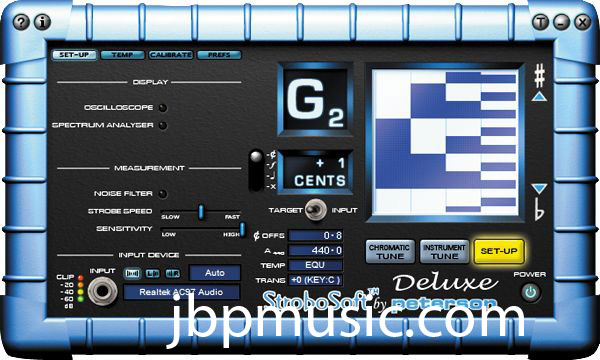
Peterson's hardware strobe tuners are the best of the best of the best. I've been interacting with them since I was in school band back in the seventies. Recent Peterson Tuners for guitar, bass and other stringed instruments include sweetened tunings. StroboSoft Deluxe also includes sweetened tunings - all of which work
WONDERS for your music and your ears!
Free Shipping and more information for Peterson StroboSoft
If you'd like to read more about StroboSoft in detail, you can visit the StroboSoft site here:
StroboSoft.
Quick Opinion: Buy this piece of software. Buy this piece of software. Buy this piece of software. Really: Buy this piece of software. Your music will sound better, your music will flow better, you'll have more time to work on your music...
If you're gigging, playing outside a studio, or on the road - invest in a hardware Peterson Tuner (and take StroboSoft's capability with you). The hardware tuners are more expensive than the average hardware tuner, but they are worth it. At some point, I'm going to save up enough sheckels and buy a StroboStomp or the rack version for myself... Their hardware is well worth twice (or more) than their current street prices.
If I can get my paws on a Peterson hardware tuner in the near future, I will write an extensive review of it, as well.
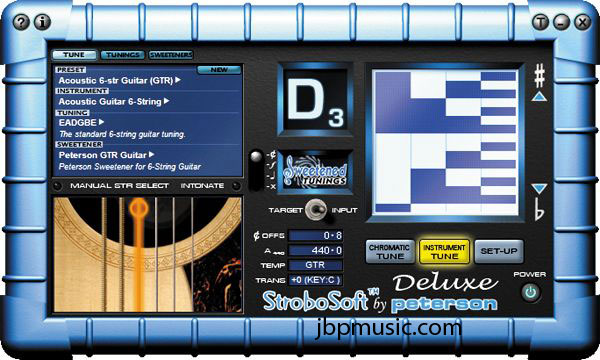 Features:
Features: StroboSoft is a snap to use. Install it, go to the setup tab, select your instrument input hardward device, click on "Instrument tune", then choose what kind of tuning you want (6 String electric? 6 String Acoustic? Sweetened? 5 String Bass?). Pluck your strings, and work your tuners/slides/instrument tuning device until the strobe stops moving up or down. You're done.
Set up for the first time takes very little time. Just take a few minutes to read their introduction, set it up, and GO. YOUR music will be sweeter, warmer, and more natural-sounding in a few minutes. Be sure to check out and set up the noise canceling feature (so it can tune easier, even on a noisy guitar or mic) - once you're up and running and understand what the tuner's doing.
Quality: I have had no issues whatsoever with StroboSoft on any of the three computers I use for recording. It has never crashed, misbehaved, or given me the first issue. Flawless.
In case you're wondering, this review is glowing because the product
REALLY deserves it - not because of any other factor.
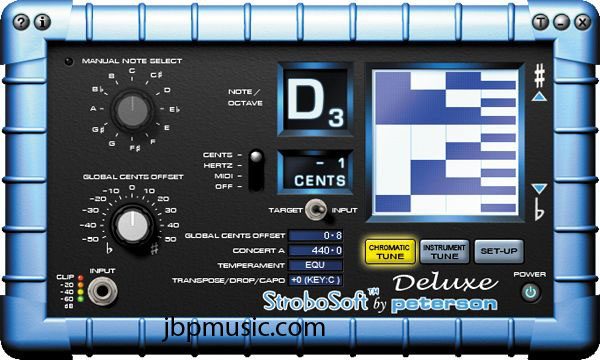 Value:
Value: In my opinion, this software is worth at least as much as Peterson Tuners' StroboFlip and StroboStomp hardware. I'm very impressed (and, frankly very, very happy) that it costs so little. The forums get answered, the emails get answered, the folks at Peterson care about their customers, and you cannot find a better value on the market.
Period.
Wishes: I'd love to see a Mac OSX dashboard widget interface to StroboSoft... just a thought...
Labels: 4 string bass, acoustic bass, acoustic guitar, computer recording, electric guitar, jimmy pearson, macintosh, osx, peterson, software, strobosoft, tuner, tuning, violin, vista, windows, xp
Epiphone Thunderbird IV Reverse Bass Guitar Review
Epiphone Thunderbird IV Reverse Bass Guitar Review
I’m lucky enough to have a couple of basses at my disposal for recording or playing. I enjoy my Jazz Standard and fretless – they’re flexible and timeless.
But, sometimes you need the noiseless, punchy, crunch of a bass guitar with a big body and humbucking pickups. I went in search of just that very thing over the past year. I played tons of different instruments from several well-known (and a few unknown) manufacturers. I started out looking exclusively at 5-string humbucking basses. I had trouble finding a 5-string in my price range – in a bass that also had good sound and playability. I couldn’t find a bass in my target price range (sub-$400) that had sound
and playability
and humbuckers
and five strings…

I had to open my search to four-string basses – which brought several great instruments into my price range. One of my long-time favorites has been the Thunderbird. The Gibson 4- and 5-string Thunderbirds are fabulous neck-through instruments. However, most musicians I know are on budgets, and/or need to have more than one bass at their disposal.
The Epiphone Thunderbird IV Reverse offers a fantastic balance among cost, function, and sound.
Free Shipping and more information here at GuitarCenter.com Quick Opinion:
Quick Opinion: The Epiphone Thunderbird IV Reverse bass guitar is cool-looking, medium-weight, low-cost, and sounds fantastic. A bass player gets a ton of guitar for her/his money with the Thunderbird.
Interestingly enough, you don’t see Thunderbirds flying around on the stages of music acts very often. Part of the allure of the Thunderbird is its "different-ness." Each and every time someone (even non-musicians) sees my Thunderbird, they remark that they really like its looks. When they hear the bass, they are struck by its flexibility and depth of sound. Part of the mystique is furthered by the fact that you don’t often see Thunderbirds in local guitar stores. The few that arrive in stock generally sell quickly enough that the floor is clear of them during most of the year.
Snag a Thunderbird. You’ll be glad you did. If you can afford the Gibson issues, get your paws on one. If your budget is tighter, you won’t be doing yourself a disservice with the Epiphone.
Playability: The Epiphone Firebird IV Reverse plays like the Les Paul of basses. The neck is wide enough to be comfortable in string-width, but is slim and tapered enough to make it easy to navigate the full range of the neck. The slick finish of the neck and the neck’s shape make playing up and down the neck a breeze. I tend to treat my bass parts as a melodic element, so I spend time on nearly all the regions of the neck – my Thunderbird’s neck really makes my bass playing more enjoyable.
The frets are nicely done, although they weren’t polished and tipped like a Gibson. The overall effort needed to press a note to the frets is a great balance between buzz-elimination and strength required. It’s easier to get a clean note from this guitar’s neck than with many other basses.
The body weight is just right. It isn’t too light (it has miles of sustain in sound as a result of the body mass), but isn’t so heavy that it makes your shoulder sore after only a half-hour of jamming. I find that my Thunderbird is as comfortable as my Standard Jazz from a weight point of view. It lacks the body contours of the Fender basses, so it’s a bit hard-edged (like most Gibson electric guitar and bass products).
The balance is slightly biased towards the neck. As with most basses, the Thunderbird can neck-dive when you take your hands off the neck. The simplest solution is to grab a wide suede leather strap (or a good strong fabric, non-nylon weave) to do a better job of holding position on your shoulder. Some players relocate the neck-side strap button further forward or even on the back of the body to help compensate. I like to be sure my guitar mods are reversible, so, I went the wide strap route. Bear something in mind here: my Jazz neck-dives about the same amount…
Features: The Epiphone Thunderbird IV Reverse bass is standard with what you would expect with most basses. It has decent sound control and tuners. The Thunderbird has a fabulous neck and excellent pickups.
It has a volume knob for each pickup and a single tone to control the sound of both pickups. The knob closest to the neck controls the volume of the mid pickup. The knob in the middle controls the volume of the bridge pickup, and the knob closest to the instrument’s tail controls the tone-shaping pot (potentiometer). If you want warmer and rounder sound, turn up middle pickup’s volume and the bridge’s volume down. To make a more growly, biting sound, do the opposite. To get the big wide sound at full throttle, turn both the volume knobs all the way up.
The Thunderbird IV comes with EMG humbucking bass pickups. This detail of the guitar is one of the key reasons I settled on a Thunderbird. These pickups are no slouch, and are phenomenal as a feature for a bass in this price range.
The tuners and neck are extremely well-done and function superbly. The tuners are stabile throughout a gig or recording session. The bridge mechanism is very versatile and has an overall height adjustment that doesn’t require tinkering with the saddles – I really like this bridge.
Quality: Not all of my reviews have a
quality heading. For the most part, I cover quality throughout the body of the review. However, the Thunderbird I purchased really needs to have its own explanation of quality.
The finish is bar-none just about perfect. It looks great, the finish feels great, and there are no bugs or flaws anywhere.
The pickup and wiring system are well above-par for Epiphones in this price range. Generally, I have to tinker with electric bits on my Epis to get what I want. With this Thunderbird, it was great – right out of the box.
The set-up of the neck and the bridge adjustments were just right when I got my bass home. I didn’t have to tune or intonate the bass at all.
Overall, this is one of the highest quality electric basses I’ve ever played in any price range.
Sound: The Thunderbird has earned its name. It sounds wonderful. What humbuckers do for the Les Paul or SG sound, the EMG humbuckers do for this Thunderbird. This bass sings, crunches, growls, and thunders.
With many basses, the sound comes through in a way that “reds-out” the VU meters/recording meters when you crank them up enough to punch through the sound of the band. This is a fairly common problem. I often play my basses through a nice tube preamp (before pedals, amp, and/or recording interface). I get lots of nice sound this way – especially more punch. However, I need the preamp much less with the Thunderbird. It has respectable output power, and is harmonically more rich than it’s near-the-same-price competitors.
In particular, you can dial in a sound that works very well with acoustic guitar sounds – with the mid pickup and a little tone-down. But, the same instrument can be dialed up to rock hard with even the most demanding of musical varieties.
I prefer my fretless Jazz for the ultra-mellow sounds – but the Thunderbird can be really smooth and inviting as well.
You can punch, crunch, and growl with this bass. It also lends itself very well to effects such as reverb, chorus, flange, and even compression or gain distortion. The breadth of its harmonics makes it very flexible and versatile.
 Value:
Value:This is an extremely excellent value bass. It is worth more than its street price, probably in the $400 to $425 range in
actual value. You get a lot for your money, and Epiphone has just lowered its Epiphone Thunderbird prices by $100 for its non-Goth models. The Thunderbird is now offered in some neat colors, too (alas, no white this time around!). You can purchase blue, traditional brown sunburst, gloss black, and a metallic red. I chose to purchase the sunburst – it was too wonderful to put down.
You get lots of sound and great electronics in this bass. I’ve not seen this level of sonic capability in any bass under $550. Only the bolt-on neck aspect separates the Thunderbird from the more costly instruments.
Wishes: I really can’t complain about anything with this bass at this price… really. If I were to offer a custom model, I’d want a few things different – even if it meant going back to the previous street price ($399).
My little wish list:
White (please!);
At least a glued-in neck (if the neck-through-body construction of the Gibson is too costly to mass-produce);
The very same bridge, but with lots more mass;
Schaller strap lock buttons!;
Would love to have two tone controls in addition to the two volume controls…
Labels: 4 string bass, bass, electric bass, epiphone sg, epiphone thunderbird, passive bass, thunderbird
Fender American Jazz 4-String Bass Review
 Fender American Jazz Bass Review
Fender American Jazz Bass Review
There are many good and extremely good manufacturers of bass guitars in the world today. We have the luxury to access a huge variety of basses in all price ranges, lots of different styles and sounds, and a mind-boggling set of choices to make when shopping for a bass guitar.
When I set out to purchase a definitive bass for the majority of my bass playing (and recording), I wanted to have a great sound, a sound that fits many styles of music, and in a guitar that doesn’t require a second mortgage to own. I took several months to play lots of different basses from different manufacturers, and in lots of different price ranges. Although a musician like me wants to have lots of tonal/playing options for his guitars, I need a solid cornerstone instrument for my bass sounds: The Fender American Jazz fits the bill in a huge way. Our Fender American Jazz (“Count Bassy”), will be a member of the family – and a treasured heirloom for many years to come.
Quick Opinion: The Fender American Jazz bass is well-rounded, sonically rich, ultimately playable, and a joy in terms of playing comfort. If you need a long-term bass guitar – one that can fit almost any musical style – The American Jazz is just the prescription the doctor ordered.
Free Shipping and more information about the American USA Fender Jazz 4-String Bass here at GuitarCenter.com Playability:
Playability: I played about a dozen bass manufacturer brands before settling on an American Jazz. After long days of playing many basses, the American Jazz felt at once comfortable and effortlessly playable. The particular Jazz I purchased felt like playing an old favorite guitar of many years (just shiny, clean, and new).
The neck is the signature for a Jazz bass – a great taper, an effortless profile, and a satin finish that always feels effortless (even when your hands get hot and sweaty). The neck and body profile make for easy access to the entire fretboard range. As a bass player who loves to use the
entire fretboard, the Jazz feels right at home. It is obvious that the person who finished my particular Jazz neck paid attention to even the tiniest of details. (However, see my note at the end concerning the fret wire ends.)

The balance of the body and neck is outstanding for a full-scale (34”) bass. Even though my American Jazz is a tiny bit biased weight to the neck, it never becomes an issue for playing long hours in my home studio. The comfortable body contours for your ribcage and pick/thump/pluck hand arm make the guitar fit to the player like a glove.
Playing our Fender American Jazz bass is a comfortable and enjoyable experience. It’s easy to look forward to recording and playing sessions when one has one of these basses to play.
Features: Another place the American Jazz Bass shines is in its feature set. The vast majority of passive basses in this price range give you tone, volume, and some nice cosmetics. The Fender gives you nice cosmetics, and gives you the wonderful
S1 switch. The S1 switch gives you additional sound choices, and can add lots of real-world punch to your sound to cut through even a big, loud band.
My only concern with most passive basses is that it is very difficult to get lots of bass frequency (without sending your equipment/recording gear way into the clip-red-range). The balance between signal volume and
punch is a difficult thing to achieve, especially for recording. The S1 switch and the wonderful advanced-magnet pickups in the American Jazz make the search for sound MUCH easier to play, hear, and EQ.
The pickguard is a classy three-layer guard. The neck is a fabulous piece of maple (I chose the maple fretboard for its playability, sound, and looks). The tuners are accurate, easy to use, and simple to maintain. The included Fender hardshell case is wonderful for protecting your Jazz baby.
Sound: I could write a short novel about the sound of the Fender American Jazz bass. (Hey Fender, do you want me to write one?) There are lots of styles of music in the world, and there are lots of wonderful-sounding basses out there from a variety of manufacturers (even several different sounds from Fender). By far, the sound of the American Jazz bass fits more styles and sound qualities than any other bass I’ve had the pleasure of playing (followed closely by the Jazz’s cousin the Fender American Precision bass).
The sound is warm when you need it, it's very vibrant and broad when you tweak it, and there’s not much out there that can growl, sizzle, spank, bite, or punch better than the American Jazz. The Jazz is loud (for a passive bass) without being intrusive, but can take a lead tone in an R&B or rock tune very easily.
The sound of my American Jazz has inspired me to compose and record duets for bass, and has led me to intuitively play melody and counter-melody with the bass.
Value: The Fender American Jazz bass is well worth its cost, if not even a little more. The combination of quality, playability, and signature sound make the purchase of a Fender American Jazz a purchase you will long enjoy.
Wishes: My particular American Jazz plays like a dream – however, the ends of the frets have not been nicely dressed. I’m accustomed to American Fenders having all the little details done without compromise. If you run your hand down the edge of the fretboard against the edge of the fret wires, you can feel sharp, jagged edges. I used some fret polish paper to take a little of the bite off the edges of the wires – but they’re still not as clean as my American Telecaster.
Labels: 4 string bass, bass, electric bass, fender, jazz, usa
Dean Playmate EAB Acoustic Electric Bass Hands-on Review
 Dean Playmate EAB Acoustic Electric Bass Review
Dean Playmate EAB Acoustic Electric Bass Review
Due to popular request and to help a little with the folks who want to hear the bass first-hand, I've uploaded another tune I recorded with my Dean EAB (the bass part). I still have the EAB (I go through lots of instruments), and I love it. This recording is a mixture between the acoustic bass and an electric semi-hollow body guitar (an Ibanez AF75D). The bass part is recorded here in my home with two Nady condenser reference mics, through a nice tube pre-amp. I chose not to use the on-board pickup because I like the acoustic sound so much.
Listen here (new window). Please feel free to share the tune, but please tell folks where you got it! It's not public domain, just free for personal use only. Any public or commercial use requires my express written permission. For more of my music, including some acoustic stuff recorded with my EAB, go to (new window)
http://jbpmusic.com.
As a recording musician, I like to have lots of different sound timbres and qualities in my "library" of guitars. Since I have a couple of nice electric basses, I began looking for a low-cost acoustic bass guitar some time ago. I played $2000 basses, and I played $99 basses at different guitar stores in our area. The top-end basses such as the Tacoma were wonderful, but were
way out of my budget. By far, the
Martin (wow! Solid sound, excellent build, bar-none timbre) and
Tacoma Thunderchief (wow! If I could afford one of these, it would be THE one!) guitars were the best sounding and the best made. Either brand, in any model, would have been a great joy to own! I also played the Fender, Ibanez, and Kelly acoustic basses – but they were above my budget as well.
My issue, however, is that I wanted a bass that sounded great
acoustically, and if it worked amplified too, then fine – and at a low price. This brought me to the Dean Playmate EAB. This bass, at $149 through sites like
Purchasing and information link plus get Free Shipping at GuitarCenter.com
was an absolute (pleasant) surprise. I ended up purchasing the Dean as my bass acoustic member of my sound palette. If you’d like to hear how it sounds when recorded through a nice acoustic microphone, go to this page:
http://jimmybear.dmusic.com and listen to
Gentle Falling Snow.
Quick Opinion: The Dean Playmate EAB Acoustic Electric Bass is a great all-around acoustic bass. It handles well, is of OK quality, and (most of all) sounds along the lines of the marvelous Tacoma acoustic basses. The primary impression of the Dean EAB Bass we bought (and have played for almost a year) is that it is a
steal of a buy, and a very interesting-sounding bass.
Playability: The Dean EAB has a long-scale neck. It feels right at home after playing my Fender American Standard Jazz bass (although the Jazz is a much easier instrument to play, and has a better neck). The frets are surprisingly well set, dressed, and are of reasonable height. The light-brown/red fretboard wood is a little dry looking, but it is very easy to play. The body size is comfortable for a tall person with long arms (such as myself). My son feels comfortable with the guitar, but my daughter ("only" 5’10") isn’t comfortable with the large and deep body. (Body size is not "good" or "bad", the Dean is about the same size as the Tacoma… It is just not comfortable for smaller players.) The string height is surprisingly low, even after I raised the strings a bit to reduce fret buzz.
The Dean’s playability is actually a high 8 or low 9. Especially after a string-change.
Features The features of the Dean Playmate EAB are reasonable. The tuners are good and strong (sort of Gotoh-style), and keep tune
very well. The rosette is traditional in look, and the saddle wood is of a very contemporary shape. The string-retention pegs are large and easy to use, and provide sufficient mass for reasonable sound (Why is it that I can’t find brass, bone, or Tusq retention pegs in the aftermarket? I’d buy some if I could find them.)
The satin finish is even, well-applied, and has very few "weird" spots. The neck’s satin finish is much smoother than the body’s finish, and is very comfortable in the hand. The Dean came with OK nickel or steel wrapped strings – they were a bit bright for me… I changed our Dean’s strings to a set of
D’Addario Phosphor Bronze soft strings (the
Martin Phosphor Bronze lights sound
really great, too – they just lose their warm, growly timbre quicker and seem to oxidize quicker.)
Sound: This is where the Dean Playmate EAB sold me: Sound. The
acoustic sound is extremely comparable to solid-wood guitars from a
much higher price range! The bass frequencies are pretty tight, and the reproduction of the string flutter comes out nice and clear. The sound is pretty good when playing up the neck, especially when I switched from nickel to phosphor-bronze strings. When correctly mic-ed, the Dean sounds so very clear and wonderful – almost as rich as a grand piano with its top open.
The electronic sound (through the passive saddle pickup) is not up to snuff, though… see the "Wishes" section of this review.
The sound of the Dean was far better than any of the $300-$600 guitars I played.
Value: This is a $300 guitar in value (not 'retail',
'street'). The acoustic sound alone, plus the nicely (comparatively) finished neck are worth more than the price of admission alone. If I were to lose this one, I would most surely buy another, even if I sold enough music to buy a Martin or Tacoma.
Wishes: There are two major concerns, and one minor concerns. These concerns are apparent not after a quick use at the guitar store, but from recording more than 10 pieces of music with the Dean EAB…
The neck is slightly warped at about the third fret. After adjusting the string height (and the neck’s overall bow from shipment), it is apparent that the truss rods aren’t the most supportive in the world. The good news, however, is that the warp is slight, doesn’t affect my playing too much, and it has not changed in the nearly yearlong time in my guitar library. I find this particular warp to be acceptable for a guitar of this price. If this were a guitar that was more than $300, I would have looked for another.
The guitar’s sound through the electronics is not very good. Even with the tone turned all the way down, and the volume nearly all the way down, the bass sounds like telephone wires being pinged (think: Star Wars sounds). I had to run it through a tube preamp and several equalizations before I liked the electronic sound at all. As it is, I do not use it electrically – only acoustically. Since my Shure SM57 does a great job mic-ing the guitar, and I can get great, CLEAN bass sound with my MXL 990 with my BlueTube preamp, I have stopped trying to use the on-board electronics.
I love my Dean EAB. I
really do. I hope I get to use it for many years to come – I just wish the finish was glossy. I also placed a pickguard on it to protect it for those rare times when I use a pick for clear attacks.
Labels: 4 string bass, acoustic bass, bass, dean, eab, piezo, playmate
Squier Jazz Affinity Bass Long-Term Review
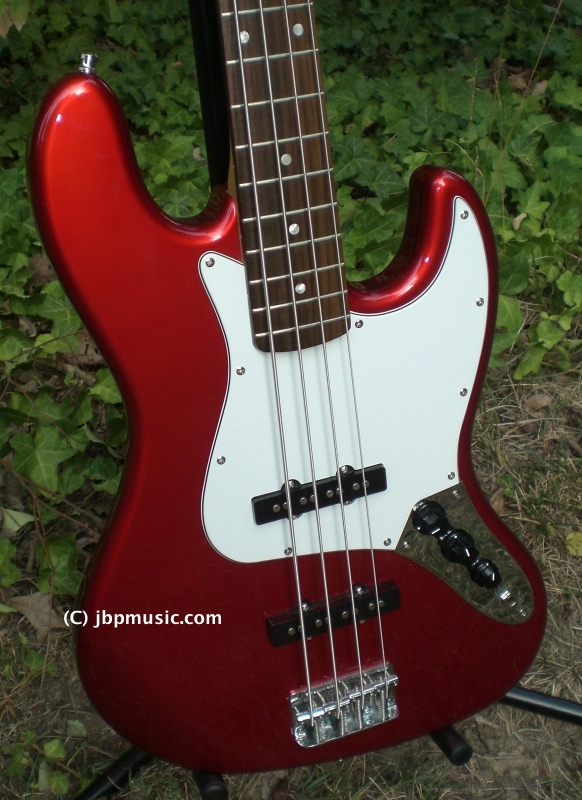 Squier Affinity J (Jazz) Bass long-term review
Squier Affinity J (Jazz) Bass long-term review
Every guitar player should try playing bass. It's a blast, and can really teach you something about fret stretches, silencing adjacent strings, and serious hand-strengthening. In another note, every bass player has to have a place to start. Sometimes getting a low-cost bass doesn’t mean having to get a
cheap bass!
Quick Opinion: The Squier Affinity and Standard Jazz Bass guitars are extremely comparable to Fender Mexican-made Standard Jazz Bass guitars! The basic features and appointments are almost identical. It stands to reason that the Chinese-made Squiers are slightly less-nice Alder wood, and the finish paint is thicker and harder on the Squiers. However, the impression of the Squier we bought (and have played for more than a year) is that it is a
solid buy, and an excellent bass.
 Free Shipping and more information about Squier by Fender Jazz basses - The Affinity 4-string Jazz may no longer be available, but check out the Vintage Modified!
Free Shipping and more information about Squier by Fender Jazz basses - The Affinity 4-string Jazz may no longer be available, but check out the Vintage Modified! Playability:
Playability: The neck is solid, and is nicely tapered. It is physically similar to Fenders costing much more… The maple neck and rosewood fretboard feel excellent and are easy to play. The bass is comparatively light and is fairly well balanced. The excellent Fender-designed double-cutaway body allows easy, full access to the entire fretboard.
As a long-scale (34”) bass, the Squier Jazz Bass is extremely playable and is a joy to use. The bolt-on maple neck/rosewood fretboard comes
surprisingly well finished. Only two or three of our guitar’s fret ends were a little sharp. The fret height is very consistent throughout the neck.
For folks with small hands or less-than-average arm lengths, a full-scale bass like this might be a little tough to play (especially during quick, challenging passes). If you’re not comfortable with a long, 34” guitar, I recommend trying out the Squier Bronco bass, or, if your budget can accommodate, a Fender Mustang bass.
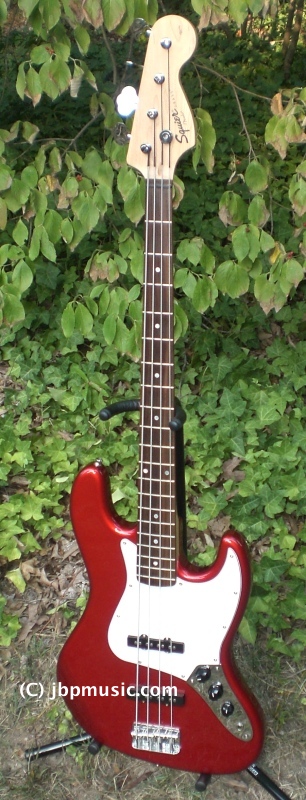 Features
Features The appointments and features of the Squier Jazz Bass are excellent for this guitar’s price. The pickguard is a well-made three-ply plastic guard (white-black-white on our Red Metallic bass). The pickups are two “vintage-style” pickups (bridge and mid). The guitar features two larger volume knobs and one smaller tone knob. The two volume knobs allow you to choose the tonal variety by selecting the volume for a specific pickup. The tone applies to the entire sound output (the Squier Jazz Bass guitars are
passive, in that they have no equalization or boost electronics on board). As with all Jazz Bass guitars, the neck is bolt-on. In the case of the Squier Jazz Bass, the neck truss rods are adjustable via an allen wrench in the headstock (no need to unbolt the neck and unscrew the pickguard). The chrome tuners are the enclosed variety, and are fairly accurate. The Squier Jazz uses a round string tree in the headstock for the two highest strings.
The Squier Jazz Bass has top-loaded strings (means that the strings are not fed through the body, but are fed through the end of the chrome bridge).
Sound: The Squier Jazz Bass guitar has a consistent, (sort of) vintage sound. The pickups are pretty noisy, and the output isn’t very strong. The quality of the sound that does come out is
all Fender, though. With the right amplification and EQ-tweaking, you can get the Squier to growl, rumble, and thumb-slap-“splank” without too much trouble. If I was to make this guitar my full-time bass – I might take the time to upgrade the pickups to Fender SCNs, or some type of high-output noiseless.
Value: This is a $299 guitar in value (not 'retail',
'street'). The sound, quality of make, and appointments are very good. Many other low-end guitars have badly twisted/warped necks, poor sound, and extremely cheap parts – the Squier Jazz Bass is very much a cut above the average low-end bass (no pun intended!). You would have to buy a much more expensive Fender bass to get better sound. If you took the labels off the Squier, you would have trouble telling it from its more expensive brethren (or sistren, if you wish).
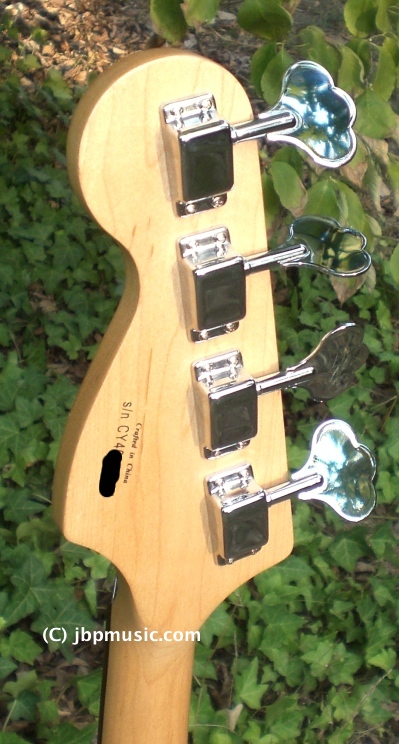 Wishes:
Wishes: I really wish these were offered with maple fretboards (a matter of personal preference, yes, but still something that would be good to offer). It would be nice if the pickups had more output.
Labels: 4 string bass, bass, electric bass, fender, jazz, squier












